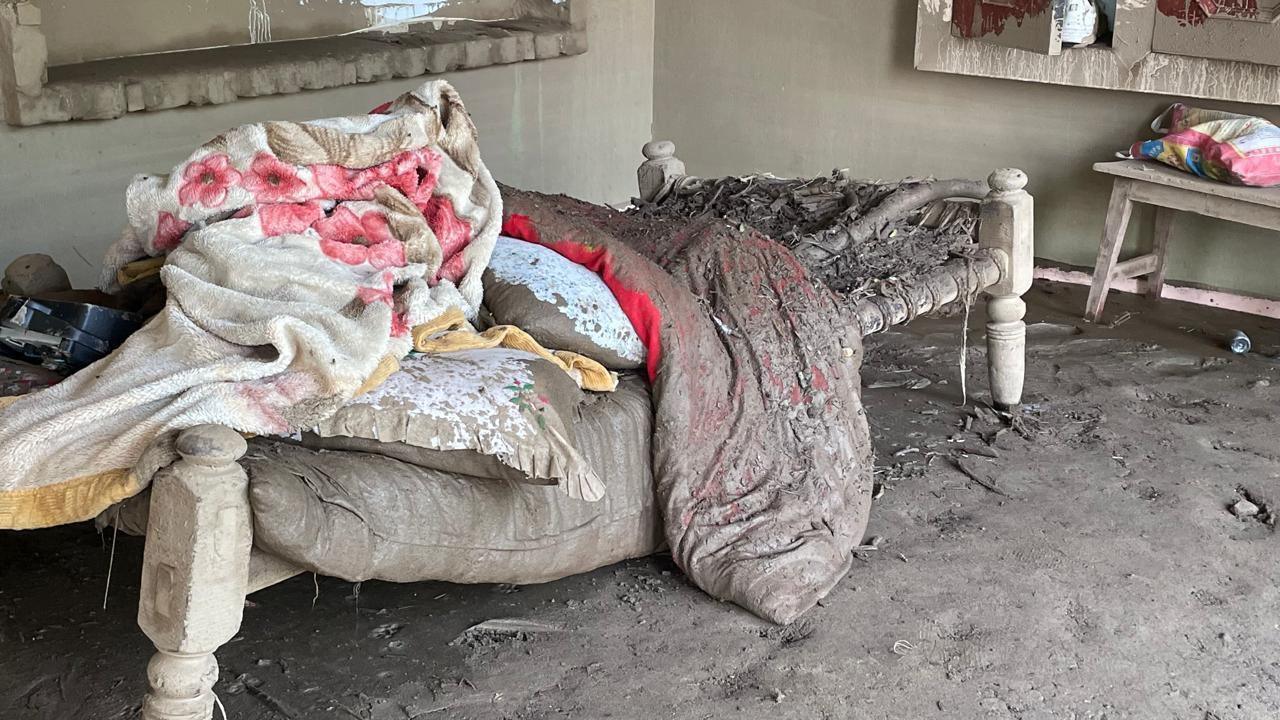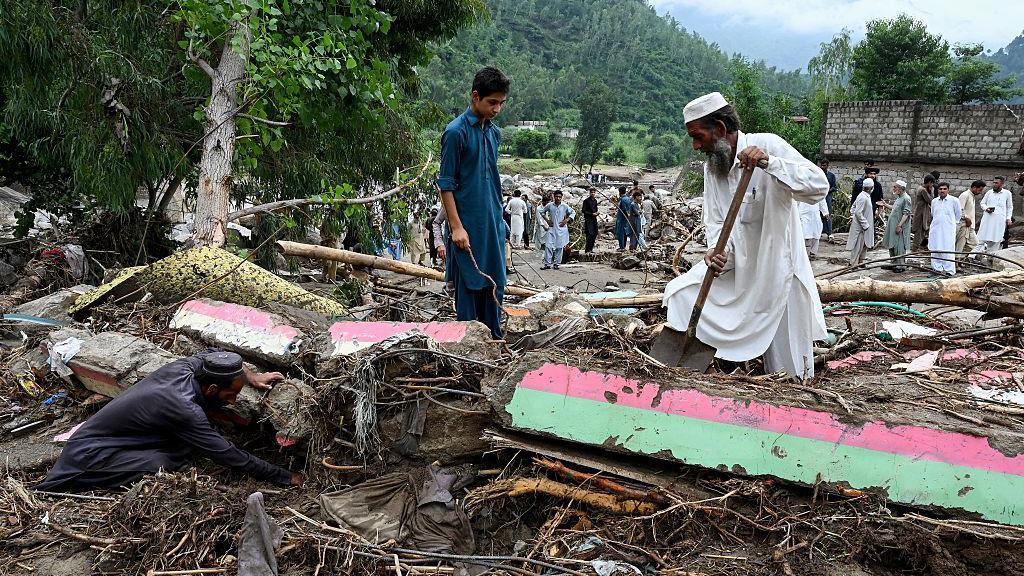'The water had no mercy': Hundreds killed as floods ravage north Pakistan
Watch: Destruction in Pakistan after flash floods that have killed hundreds
- Published
Nestled among the lush green mountains of Pakistan's north, and with a river flowing serenely through its centre, Bishnoi was, until recently, a beautiful village.
But it had rained heavily on the morning of Friday, 15 August, and when the villagers woke early and went off to work they were unaware of how swiftly things were about to change.
According to locals, a sudden torrent of water came surging through Bishnoi, "bringing huge rocks with it and crushing buildings in its path, destroying the entire village".
When BBC Urdu visited in the aftermath, the area was dotted with large stones, concrete blocks and uprooted trees. Without heavy machinery, rescue workers and locals were busy clearing the debris using small tools.
"There is a house under every stone. People try to look under these rocks to see if they can find someone," local Israr Khan explained. "The houses are buried under the ground."
Across the wider province of Khyber Pakhtunkhwa, at least 314 people have been killed and 156 injured due to rains and flash floods that began between Thursday and Friday night.
Buner district, where Bishnoi is located, is the worst-affected, with 217 fatalities, according to the Provincial Disaster Management Authority (PDMA).
Another local said many people had been killed in a house where wedding preparations were underway. Others told us there had been a total of 80 to 90 households in Bishnoi, most of them involved in farming.
An estimated 50% of the houses have been completely destroyed in the flood. The rest are no longer habitable.
A devastating monsoon season
Monsoon rains between June and September deliver about three-quarters of South Asia's annual rainfall. Landslides and flooding are common, and 650 people have already died in this year's season.
In Pakistan, at least 507 people have died and more than 700 have been injured in rain-related incidents since the monsoon started in late June, according to the National Disaster Management Agency.
Punjab and parts of Islamabad are among the areas that have been battered by heavy downpours and flash floods so far this year. But neither have been hit harder than Pakistan's mountainous north, home to Khyber Pakhtunkhwa and one of the most glaciated areas in the region.
Global warming is causing these glaciers to quickly thin and retreat, in turn making debris such as rocks, soil and other materials more vulnerable to being dislodged. And while the exact cause of the recent floods and landslides are yet to be determined, glaciologists say that ice melt is a contributing factor.
Government forecasters have warned that heavy rainfall is expected until 21 August in the north-west, where several areas have been declared disaster zones.

Floods and landslides are devastating villages in Pakistan's mountainous north
In the Swat Valley, less than 100km from Buner, a school principal saved nearly 900 students from the floods.
"It was exactly 09:00 when I had a last glance at the stream and sensed it was going to burst its banks due to continuing rains," Saeed Ahmad, 59, told Anadolu news agency.
Mr Ahmad ordered an immediate evacuation, and within 15 minutes all teachers and children had left - moments before raging floodwaters surged through the school, washing away half the building, its boundary walls and playground.
Sarwar Khan, a local councillor, said "this timely action by the principal saved 900 lives".
Others were not so fortunate. Abdul Salam, who lives in Punjab, told BBC Urdu of the moment he realised his wife, two daughters and son may have been caught in the Swat Valley floods.
"I started dialling numbers on my mobile phone like crazy, but I couldn't get in touch with my wife and children," he said. All four of them drowned.
Meanwhile, in Buner, Asrar Khan said that 27 people from his village were still missing.
When asked how the disaster unfolded, he took a deep breath.
"It all happened before my eyes," he said - and explained that although he and others had managed to save some people, "the water was so strong it had no mercy on anyone".
'The search is ongoing'
Crops lay flattened on both sides of the road on the drive towards Buner's Pir Baba Bazaar. Trees were uprooted and vehicles were in ruins - sometimes stuck in mud, sometimes in walls.
Arriving at the market, other details of the destruction were visible.
The intensity of the floods were clear from the fact that the water had reached the third floor. Some shops had collapsed. Sugar sacks and women's clothes were littered in the mud, with vehicles passing over them.
The shopkeepers had started working on their own, removing mud and water from their shops.

Flood survivors and people from far-flung areas have helped with the relief effort
In Bishnoi, Al-Khidmat and other relief agencies were hard at work, with goods being distributed among the people and a medical camp set up. Rescue and other agencies, along with military personnel, were busy with the restoration work, while heavy machinery was also arriving.
But people from far-flung areas had also come to the disaster zone to help those affected.
At one point, two young men came and sat down on a stone, their feet encrusted in mud.
"They're looking at the house in front," another man explained.
The house is not immediately obvious - until, that is, he pointed to a foundations that had once been a home to 20 family members.
"Eighteen of them are no longer there," he said. "Some bodies have been found and the search for others is ongoing."
Two people had survived, he added, but they had been unconscious and seemed confused about the situation.
"Their understanding is not working," he explained. "If anyone asks them anything, they start crying."